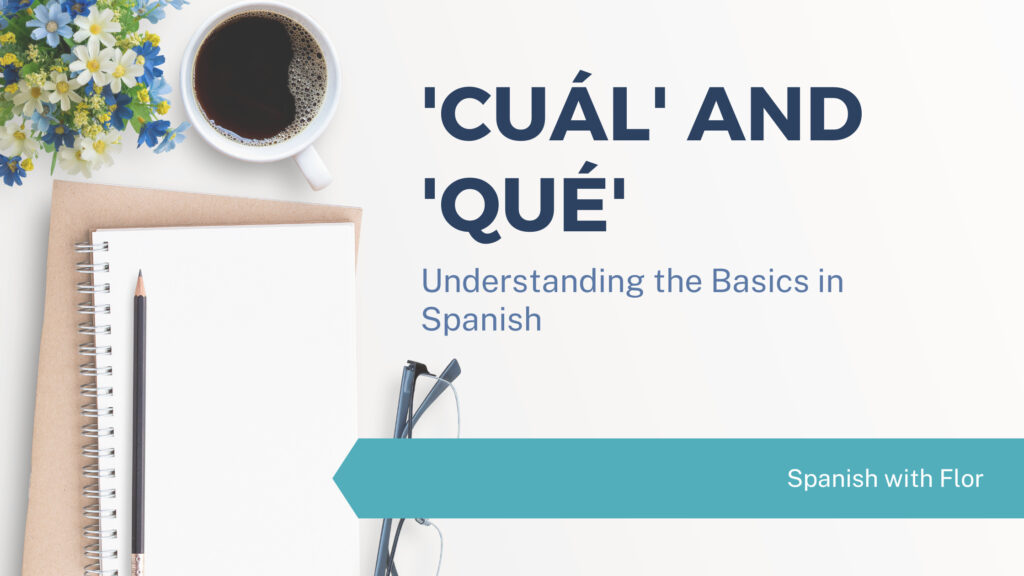In Spanish, ‘cuál‘ (with an accent mark) is an interrogative pronoun that is used to ask about identity or to make a choice between a limited number of options. ‘Qué‘ (with an accent mark or tilde) is another interrogative pronoun in Spanish that is used to ask for a definition or explanation.
It is also a relative pronoun that means ‘like’ or ‘as’. In general, ‘cuál’ is used when the speaker has a specific set of options in mind and is asking the listener to choose one of them.
Here are some examples with ‘cuál’ in sentences:
- ¿Cuál es tu nombre? (What is your name?)
- ¿Cuál prefieres, la pizza o la hamburguesa? (Which do you prefer, pizza or hamburgers?)
- ¿Cuál te gusta más? (Which one do you like the most?)
Here are some examples with ‘qué’ in sentences:
- ¿Qué es el pronombre? (What is a pronoun?)
- ¿Qué hora es? (What time is it?)
- ¿Qué te parece mi nuevo vestido? (What do you think of my new dress?)
- ¿Qué sería de nosotros sin ti? (What would we do without you?)
Defining ‘Qué’
‘Qué’ is another interrogative pronoun in Spanish that is used to ask for a definition or explanation. It is also used to ask about the nature or quality of something. In general, ‘qué’ is used when the speaker does not have a specific set of options in mind and is asking for a general answer.
Here are some examples of how to use ‘qué’ in sentences:
In summary, ‘cuál’ is used when the speaker has a specific set of options in mind and is asking the listener to choose one of them, while ‘qué’ is used when the speaker is asking for a general answer or definition.
Related Posts:
How to use ‘Cuál’ and ‘Qué’ in Questions
When asking questions in Spanish, it is important to know when to use ‘cuál’ and when to use ‘qué’. Both words can be translated to ‘what’ or ‘which’ in English, but they have different uses and nuances.
‘Cuál’ in Questions
‘Cuál‘ is used when asking for a specific thing or person out of a group of options. It is often translated to ‘which’ in English. For example:
- ¿Cuál es tu color favorito? (What is your favorite color?)
- ¿Cuál es la capital de Francia? (What is the capital of France?)
- ¿Cuál camisa te gusta más? (Which shirt do you like more?)
In these examples, ‘cuál’ is used to ask for a specific answer out of a group of options. It is important to note that ‘cuál’ agrees in number with the noun it refers to. For example:
- ¿Cuáles son tus películas favoritas? (What are your favorite movies?)
In this example, ‘cuáles‘ agrees in number with ‘películas‘, which is plural.
‘Qué’ in Questions
‘Qué‘ is used when asking for a definition or explanation of something. It is often translated to ‘what’ in English. For example:
- ¿Qué es la democracia? (What is democracy?)
- ¿Qué significa esta palabra? (What does this word mean?)
- ¿Qué hora es? (What time is it?)
In these examples, ‘qué‘ is used to ask for a definition or explanation of something. It is important to note that ‘qué‘ does not agree in gender or number with the noun it refers to.
Related Posts:
How to use ‘Cuál’ and ‘Qué’ in Statements
In statements, ‘cuál‘ is used to specify or identify a particular choice or option. For example:
- Elige cuál camisa quieres ponerte. (Choose which shirt you want to wear.)
- No sé cuál película vamos a ver. (I don’t know which movie we’re going to watch.)
- Dime cuál es tu dirección. (Tell me what your address is.)
In statements, ‘qué‘ is used to ask for a general description or explanation. For example:
- No sé qué hacer. (I don’t know what to do.)
- Dime qué te gusta hacer en tu tiempo libre. (Tell me what you like to do in your free time.)
- Quiero saber qué piensas sobre este tema. (I want to know what you think about this topic.)

